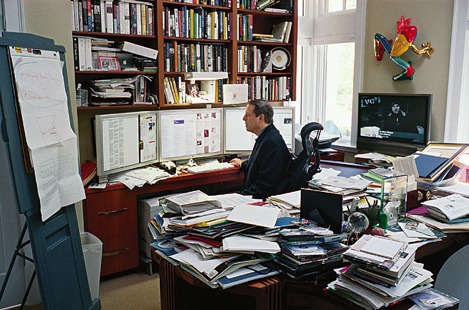Don Norman on Emotions and Complexity
Here's an interesting video of Don Norman speaking at the Business of Software conference in 2009:
Sometimes, I wonder whether Don Norman is playing a huge practical joke on the usability community, with his more recent ideas on things like complexity, and usability. He makes some great points in this talk, but he also makes a number of rather peculiar arguments.
For example, at the very beginning of the video, he claims that usability won't affect the sales of a product, because people profit from usability only after they have already bought a device. But this completely ignores the fact that people recommend products they like to other people. Devices like the Wii, the iPad, or the iPhone are viral; people become interested in buying them after playing with a friend's device, and after seeing how much their friends enjoy using their devices.
Creating a Mess
Later in his speech, he talks about advantages of complex products. He makes the point that complexity is sometimes a necessary attribute of a product. I agree with this point, but I think he's overstating the case; some of the examples he uses are a bit odd. One of these examples is Al Gore's office:

However, Al Gore's office does not illustrate Norman's point. Al Gore's office does not look like this because he uses a complex product. Instead, he uses simple things (like pieces of paper) to create a complex structure (otherwise known as a mess). Letting your users create complex structures and arrangements is an entirely different idea from creating products that are complex on their own.
In other words, your users' messes make perfect sense to your users. Your mess, on the other hand, makes absolutely no sense to them. Complexity is easily understood by the person who created the complexity, but often not by anyone else. I understand the mess on my desk, but not the mess on yours. The fact that people create complex structures does not mean that they will be happy with complex products, because it's not their mess; it's somebody else's mess.
Art
Norman also uses a weirdly complex coffee machine as an example of how complexity can make a product more fun. It's true that this is a complex product, and it's also true that this looks like a fun product, but is it really something we should emulate?

Such devices may be "fun" in a slightly abstract sense,1 but does anyone actually use these things to make coffee?2 I certainly don't know anyone who uses such Rube Goldberg-esque devices. They're fun objects in the same way that a sculptural machine by Jean Tinguely is a fun object, but they are not fun to use on a regular basis.
They are works of art, and not intended as functional devices.
We like to look at them, and maybe play with them once in a while, but we don't want to use them regularly.3 We don't use them when we need to get stuff done. To me, this example actually reinforces the idea that "fun" should not be the primary goal when we are trying to create functional products; functional should be the primary goal. People experience fun naturally when they use a product that makes them feel in control—in other words, a usable product.
Do we really want to create the equivalent of a device that nobody truly uses, a device that is essentially a piece of art, rather than a product that people will use when they need to get things done?
Norman's main point is that emotions are the most important factor influencing how people behave. I agree. But emotions don't exist in a vacuum. Emotions are a product of something else. Very often, positive emotions are a result of a great user experience. And a great experience, in turn, is (not exclusively, but in large parts) the result of a product that is easy to use.
-
By which I mean that the concept of the machine, or the idea that such a machine exists at all, is fun. ↩︎
-
You'd think I'd have learned not to ask rhetorical questions that have actual answers by now, but apparently not. A friend of mine who really likes coffee tells me that this coffee machine is called an "Elektra Verticale", and that there actually are people who use this thing to make coffee, although not very many. Ostensibly, the motivation for using the device is that it makes great coffee, which makes at least some people willing to put up with the added complexity. Looking at more detailed pictures of this device, I also begin to suspect that Norman is overstating the complexity of this machine's user interface. It looks a lot more complex than it actually is because there are several individual cup holder and nozzles attached to the outside of the device that don't much interfere with operating the device, but make it look much more complex. ↩︎
-
My dad owns an old phonograph that he sometimes takes out to play music when he has guests. It's a fun device, and it works in the sense that it produces something approximating music. But it's not the device he uses when he wants to listen to music; the device he actually uses is a simple CD player that is not really fun per se, but is easy to use and works well, which results in a much better user experience. ↩︎
If you require a short url to link to this article, please use http://ignco.de/307




